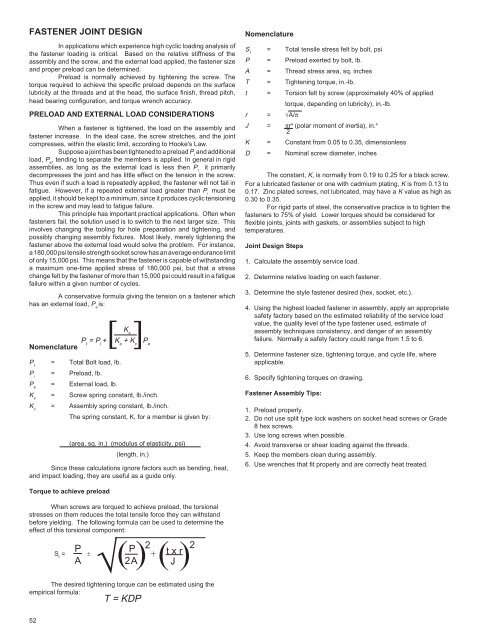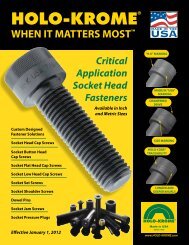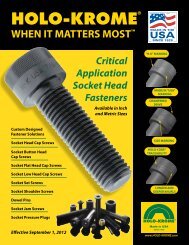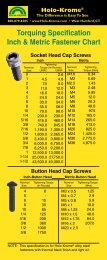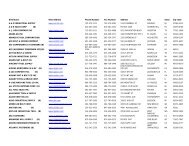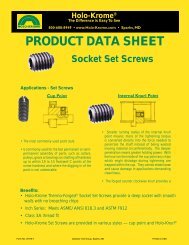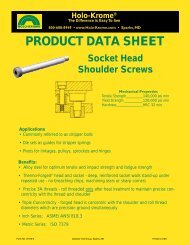Consolidated Tech Man - Holo-Krome
Consolidated Tech Man - Holo-Krome
Consolidated Tech Man - Holo-Krome
You also want an ePaper? Increase the reach of your titles
YUMPU automatically turns print PDFs into web optimized ePapers that Google loves.
FASTENER JOINT DESIGN<br />
In applications which experience high cyclic loading analysis of<br />
the fastener loading is critical. Based on the relative stiffness of the<br />
assembly and the screw, and the external load applied, the fastener size<br />
and proper preload can be determined.<br />
Preload is normally achieved by tightening the screw. The<br />
torque required to achieve the specific preload depends on the surface<br />
lubricity at the threads and at the head, the surface finish, thread pitch,<br />
head bearing configuration, and torque wrench accuracy.<br />
PRELOAD AND EXTERNAL LOAD CONSIDERATIONS<br />
When a fastener is tightened, the load on the assembly and<br />
fastener increase. In the ideal case, the screw stretches, and the joint<br />
compresses, within the elastic limit, according to Hooke's Law.<br />
Suppose a joint has been tightened to a preload P i and additional<br />
load, P e , tending to separate the members is applied. In general in rigid<br />
assemblies, as long as the external load is less then P t it primarily<br />
decompresses the joint and has little effect on the tension in the screw.<br />
Thus even if such a load is repeatedly applied, the fastener will not fail in<br />
fatigue. However, if a repeated external load greater than P i must be<br />
applied, it should be kept to a minimum, since it produces cyclic tensioning<br />
in the screw and may lead to fatigue failure.<br />
This principle has important practical applications. Often when<br />
fasteners fail, the solution used is to switch to the next larger size. This<br />
involves changing the tooling for hole preparation and tightening, and<br />
possibly changing assembly fixtures. Most likely, merely tightening the<br />
fastener above the external load would solve the problem. For instance,<br />
a 180,000 psi tensile strength socket screw has an average endurance limit<br />
of only 15,000 psi. This means that the fastener is capable of withstanding<br />
a maximum one-time applied stress of 180,000 psi, but that a stress<br />
change felt by the fastener of more than 15,000 psi could result in a fatigue<br />
failure within a given number of cycles.<br />
A conservative formula giving the tension on a fastener which<br />
has an external load, P e is:<br />
[ ] Ks P = P + K + K P t i s c e<br />
Nomenclature<br />
Pt = Total Bolt load, lb.<br />
Pi = Preload, lb.<br />
Pe = External load, lb.<br />
Ks = Screw spring constant, lb./inch.<br />
Kc = Assembly spring constant, lb./inch.<br />
The spring constant, K, for a member is given by:<br />
52<br />
(area, sq. in.) (modulus of elasticity, psi)<br />
(length, in.)<br />
Since these calculations ignore factors such as bending, heat,<br />
and impact loading, they are useful as a guide only.<br />
Torque to achieve preload<br />
When screws are torqued to achieve preload, the torsional<br />
stresses on them reduces the total tensile force they can withstand<br />
before yielding. The following formula can be used to determine the<br />
effect of this torsional component:<br />
P ( S = ±<br />
t<br />
A<br />
√ 2 J A<br />
P)<br />
+( ) t x r 2<br />
2<br />
The desired tightening torque can be estimated using the<br />
empirical formula:<br />
T = KDP<br />
Nomenclature<br />
S t = Total tensile stress felt by bolt, psi<br />
P = Preload exerted by bolt, lb.<br />
A = Thread stress area, sq. inches<br />
T = Tightening torque, in.-lb.<br />
t = Torsion felt by screw (approximately 40% of applied<br />
torque, depending on lubricity), in.-lb.<br />
r = √A/π<br />
J = πr4 (polar moment of inertia), in. 4<br />
2<br />
K = Constant from 0.05 to 0.35, dimensionless<br />
D = Nominal screw diameter, inches<br />
The constant, K, is normally from 0.19 to 0.25 for a black screw.<br />
For a lubricated fastener or one with cadmium plating, K is from 0.13 to<br />
0.17. Zinc plated screws, not lubricated, may have a K value as high as<br />
0.30 to 0.35.<br />
For rigid parts of steel, the conservative practice is to tighten the<br />
fasteners to 75% of yield. Lower torques should be considered for<br />
flexible joints, joints with gaskets, or assemblies subject to high<br />
temperatures.<br />
Joint Design Steps<br />
1. Calculate the assembly service load.<br />
2. Determine relative loading on each fastener.<br />
3. Determine the style fastener desired (hex, socket, etc.).<br />
4. Using the highest loaded fastener in assembly, apply an appropriate<br />
safety factory based on the estimated reliability of the service load<br />
value, the quality level of the type fastener used, estimate of<br />
assembly techniques consistency, and danger of an assembly<br />
failure. Normally a safety factory could range from 1.5 to 6.<br />
5. Determine fastener size, tightening torque, and cycle life, where<br />
applicable.<br />
6. Specify tightening torques on drawing.<br />
Fastener Assembly Tips:<br />
1. Preload properly.<br />
2. Do not use split type lock washers on socket head screws or Grade<br />
8 hex screws.<br />
3. Use long screws when possible.<br />
4. Avoid transverse or shear loading against the threads.<br />
5. Keep the members clean during assembly.<br />
6. Use wrenches that fit properly and are correctly heat treated.


